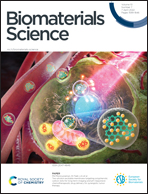Construction of antibacterial adhesion surfaces based on bioinspired borneol-containing glycopolymers†
Abstract
Preparation of antibacterial coating materials is considered an effective strategy to prevent medical device-related infections. In the present study, by combining 2-lactobionamidoethyl methacrylamide with a uniquely structured borneol compound, new copolymers poly(2-lactobionamidoethyl methacrylamide-co-glycidyl methacrylate-co-isobornyl acrylate) (poly(LAEMA-co-GMA-co-BA)) were synthesized by a simple free-radical polymerization. An amine containing silane layer was first prepared on the substrate surface by a silanization reaction. The glycopolymers were grafted onto the silane layer through covalent bonding to obtain glycosylated coatings. X-ray photoelectron spectroscopy (XPS) confirmed the successful preparation of the APTES-functionalized surface and polymer layers. The surface wettability was measured by the contact angle (CA). The coated surfaces were relatively flat and smooth as confirmed by Atomic Force Microscopy (AFM). Moreover, the prepared coatings showed good antibacterial adhesion properties toward both E. coli and S. aureus. Furthermore, no significant cytotoxicity to the MRC-5 cells (lung fibroblasts) in vitro was observed, indicating the good biocompatibility of the antibacterial coatings. This study provides an excellent strategy for designing an antibacterial surface containing glycopolymers and natural antibacterial compounds, and these coatings may be suitable for medical devices.



 Please wait while we load your content...
Please wait while we load your content...